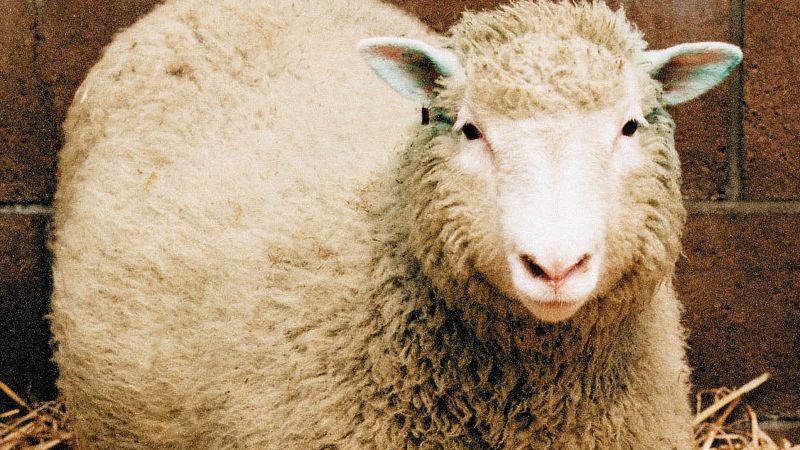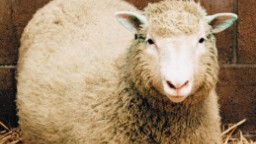CNN
—
Here’s some background information about cloning, a process of creating an identical copy of an original.
Reproductive Cloning is the process of making a full living copy of an organism. Reproductive cloning of animals transplants nuclei from body cells into eggs that have had their nucleus removed. That egg is then stimulated to divide using an electrical charge and is implanted into the uterus of a female.
Therapeutic Cloning is the process where nuclear transplantation of a patient’s own cells makes an oocyte from which immune-compatible cells (especially stem cells) can be derived for transplant. These cells are stimulated to divide and are grown in a Petri dish rather than in the uterus.
Gene Cloning creates copies of genes or DNA fragments. Gene cloning is the most common form of cloning performed by researchers at the National Human Genome Research Institute. Genes are cloned for scientists to study in a laboratory setting.
1952 – Scientists demonstrate they can remove the nucleus from a frog’s egg, replace it with the nucleus of an embryonic frog cell, and get the egg to develop into a tadpole.
1963 – Chinese scientists reportedly create the first cloned fish by transferring the DNA from a male carp into the egg of a female carp.
1984 – A researcher in Britain claims that he has cloned the first mammal, a lamb that was produced via the nuclear transfer of sheep embryo cells.
February 22, 1997 – Scientists reveal Dolly the sheep, the first mammal to be cloned from cells of an adult animal. She was actually born on July 5, 1996.
1998 – More than 50 mice are reportedly cloned from a single mouse over several generations. Separately, eight calves are reportedly cloned from a cow.
2000 – Pigs and a goat are reportedly cloned from adult cells.
2001 – Advanced Cell Technology of Worcester, Massachusetts, says it produced a six-cell cloned human embryo, in research aimed at harvesting stem cells. Separately, five bulls are cloned from a champion show cattle named Full Flush.
2002 – Rabbits and a kitten are reportedly cloned from adult cells.
December 27, 2002 – Clonaid claims to produce first human clone, a baby girl, Eve. The company declines to provide proof that Eve is a clone or even that she exists.
January 23, 2003 – Clonaid claims to have cloned the first baby boy. The baby was allegedly cloned from tissue taken from the Japanese couple’s comatose 2-year-old boy, who was killed in an accident in 2001. Clonaid again declined to provide physical evidence of the cloning.
February 14, 2003 – The Roslin Institute confirms that Dolly, the world’s first cloned mammal, was euthanized after being diagnosed with progressive lung disease. She was 6 years old.
May 4, 2003 – Scientists at the University of Idaho say they have cloned a mule, naming it Idaho Gem. Two additional mules are cloned that same year as part of a joint project between the University of Idaho and Utah State University.
August 6, 2003 – Scientists at the Laboratory of Reproductive Technology in Cremona, Italy, say they have created the world’s first cloned horse, Prometea, from an adult cell taken from the horse who gave birth to her.
September 26, 2003 – The journal Science reports that French scientists at the National Institute of Agricultural Research at Joy en Josas, France, have cloned rats for the first time.
February 12, 2004 – South Korean researchers falsely report they have created human embryos through cloning and extracted embryonic stem cells. An investigative panel concludes in 2006 that the human stem cell cloning research was faked.
August 3, 2005 – South Korean researchers announce they have successfully cloned a dog, an Afghan hound named Snuppy.
2008-2009 – Five cloned puppies from Trakr, a German Shepherd Sept. 11 Ground Zero rescue dog, are born.
May 2009 – A clone of two-time quarter horse world champion Tailor Fit is born, one of several cloned horses born that year.
September 2011 – At South Korea’s Incheon Airport, seven “super clone” sniffer-dogs are dispatched to detect contraband luggage. They are all golden Labrador Retrievers that are genetically identical to Chase, who was the top drug detention canine until he retired in 2007.
May 15, 2013 – Oregon Health & Science University researchers report in the journal Cell that they have successfully reprogrammed human skin cells back to their embryonic state.
April 2014 – For the first time, cloning technologies are used to generate stem cells that are genetically matched to adult patients. Scientists put the nucleus of an adult skin cell inside an egg and the reconstructed egg went through the initial stages of embryonic development, according to research published in the journal Cell Stem Cell.
January 24, 2018 – For the first time, scientists say they created cloned primates using the same complicated cloning technique that made Dolly the sheep in 1996. Shanghai scientists created two genetically identical long-tailed macaques. The research is published in the journal Cell.
February 18, 2021 – Scientists announce that for the first time, they have cloned an endangered US animal, creating a black-footed ferret named Elizabeth Ann from the frozen cells of an ancestor in a landmark achievement that boosts conservation efforts.
March 17, 2021 – Scientists announce in the journal Nature that they have generated a model of an early human embryo, called iBlastoids, by reprogramming skin cells. Researchers imagine its usage to include aiding with in vitro fertilization therapies and the study of early human development. The model cannot develop into a human being.

